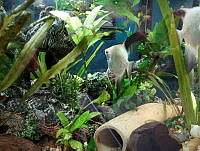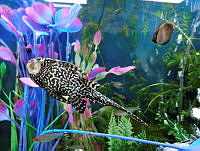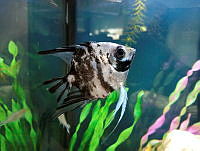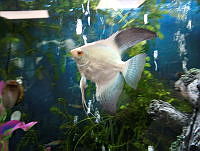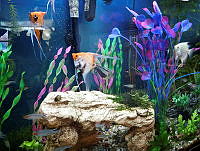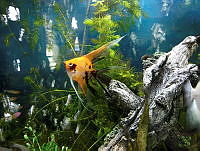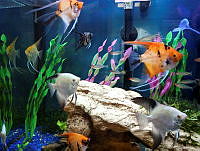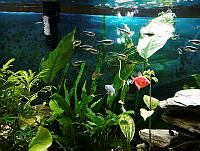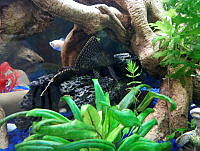Overview:
These peaceful and hardy fish have been in the hobby for a long time. Growing quite large and showing a high level of intelligence, the Pleco is sure to remain an aquatic favorite.
Quick stats:
Listed tank sizes are the minimum
Size: Up to 20 inches! (50.0 cm)
Tank: 48 inches when young, 72 + when adult
Strata: Bottom
PH: 6.5 to 7.5
Hardness: Soft to medium. dh Range 1.0-30.0
Temperature: 72 to 86°F (23-30°C)
Classification:
Order: Siluriformes
Family: Loricariidae
Genera: Pterygoplichthys
Common name:
Pleco, Plec
Amazonia, in Peru, Bolivia and Paraguay.
General Body Form:
The Pleco is elongated and has an almost flat belly and a convex back area. The most prominent feature is the large Dorsal fin, which has one large ray and seven, soft rays, which can be easily seen when it is extended. The tail fin is a mirror of itself with the lower edge and upper edge both being identical. The mouth is ventral and large and has on pair of barbells. They can grow quite large but usually stay smaller in all but the biggest aquaria.
Coloration:
The overall coloration appears to be a dark Brown. The upper-side is Brown with dark Brown spots and often has up to five wide dark transverse bands. The belly is creamy white, without markings The fins are also Brown, with rows of dark Brown spots between the rays. The nose has a thin band connecting the nostrils.
Maintenance:
The Plecos are all twilight animals and are most active at this time. Kept in a well large well planted community aquarium with pieces of driftwood for scraping. A soft substrate is also beneficial as some like to burrow. A diet high in vegetable matter is essential to their health and can be supplemented with Romaine lettuce or boiled spinach. Too much animal matter in the diet can cause digestive problems. They generally leave small fish alone, but occasionally will eat any that present themselves to them. They are hardy and undemanding in the water parameters, but will do best in soft water with a temperature in the mid seventies. The pleco is very long lived and will make a fantastic addition to any tank.
Biotope:
Calm, slow moving waters of the amazon and its tributaries.
Breeding:
Breeding of members in the family Loricariidae has been done fairly regularly. The aquarium should have tubes or clay pipes with a fairly large diameter. The male will clean the site and will fan water over the eggs and fry. At a temperature of about 70f the eggs will hatch in about nine days. The fry will eat small flake food as well as baby brine shrimp and algae scrapings. They are not the easiest to raise and a bare bottom tank is best.
90gal Tank
Aquatop Canister Filter w/UV
Overview:
These peaceful and hardy fish have been in the hobby for a long time. Growing quite large and showing a high level of intelligence, the Pleco is sure to remain an aquatic favorite.
Quick stats:
Listed tank sizes are the minimum
Size: Up to 20 inches! (50.0 cm)
Tank: 48 inches when young, 72 + when adult
Strata: Bottom
PH: 6.5 to 7.5
Hardness: Soft to medium. dh Range 1.0-30.0
Temperature: 72 to 86°F (23-30°C)
Classification:
Order: Siluriformes
Family: Loricariidae
Genera: Pterygoplichthys
Common name:
Pleco, Plec
Amazonia, in Peru, Bolivia and Paraguay.
General Body Form:
The Pleco is elongated and has an almost flat belly and a convex back area. The most prominent feature is the large Dorsal fin, which has one large ray and seven, soft rays, which can be easily seen when it is extended. The tail fin is a mirror of itself with the lower edge and upper edge both being identical. The mouth is ventral and large and has on pair of barbells. They can grow quite large but usually stay smaller in all but the biggest aquaria.
Coloration:
The overall coloration appears to be a dark Brown. The upper-side is Brown with dark Brown spots and often has up to five wide dark transverse bands. The belly is creamy white, without markings The fins are also Brown, with rows of dark Brown spots between the rays. The nose has a thin band connecting the nostrils.
Maintenance:
The Plecos are all twilight animals and are most active at this time. Kept in a well large well planted community aquarium with pieces of driftwood for scraping. A soft substrate is also beneficial as some like to burrow. A diet high in vegetable matter is essential to their health and can be supplemented with Romaine lettuce or boiled spinach. Too much animal matter in the diet can cause digestive problems. They generally leave small fish alone, but occasionally will eat any that present themselves to them. They are hardy and undemanding in the water parameters, but will do best in soft water with a temperature in the mid seventies. The pleco is very long lived and will make a fantastic addition to any tank.
Biotope:
Calm, slow moving waters of the amazon and its tributaries.
Breeding:
Breeding of members in the family Loricariidae has been done fairly regularly. The aquarium should have tubes or clay pipes with a fairly large diameter. The male will clean the site and will fan water over the eggs and fry. At a temperature of about 70f the eggs will hatch in about nine days. The fry will eat small flake food as well as baby brine shrimp and algae scrapings. They are not the easiest to raise and a bare bottom tank is best.
90gal Tank
Aquatop Canister Filter w/UV
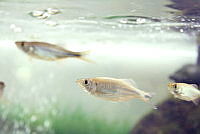
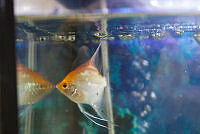

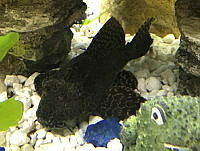
.jpg.nyeKydT6MVMt-4FjkAMA.VOe6aI-Sga.jpg)
.jpg.nyfg5dj6MVEt-4FjkAMA.VNXfMDdGKu.jpg)
.jpg.nyfAr9z6MVEt-4FjkAMA.a-7XbaeBBM.jpg)
